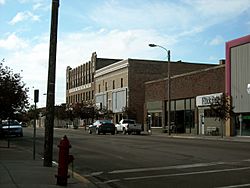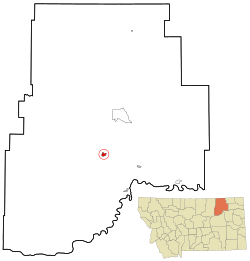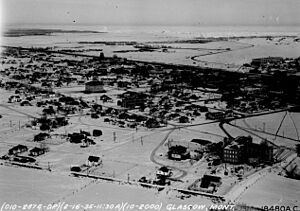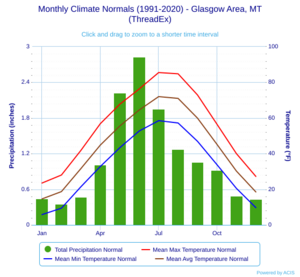Glasgow, Montana facts for kids
Quick facts for kids
Glasgow, Montana
|
|
|---|---|

Downtown Glasgow
|
|

Location of Glasgow, Montana
|
|
| Country | United States |
| State | Montana |
| County | Valley |
| Founded | 1887 |
| Area | |
| • Total | 1.40 sq mi (3.63 km2) |
| • Land | 1.40 sq mi (3.63 km2) |
| • Water | 0.00 sq mi (0.00 km2) |
| Elevation | 2,113 ft (644 m) |
| Population
(2020)
|
|
| • Total | 3,202 |
| • Density | 2,282.25/sq mi (880.89/km2) |
| Time zone | UTC−7 (Mountain) |
| • Summer (DST) | UTC−6 (Mountain) |
| ZIP codes |
59230–59231
|
| Area code(s) | 406 |
| FIPS code | 30-31075 |
| GNIS feature ID | 2410594 |
Glasgow is a city in Montana, United States. It is the main city of Valley County. In 2020, about 3,202 people lived there.
Even though Glasgow is not one of Montana's biggest cities, it is very important. It is the largest city for over 110 miles around. This makes it a key place for business and services in Eastern Montana. Both Amtrak trains and the National Weather Service have offices here. They help connect Glasgow to the wider area.
Contents
History of Glasgow
For hundreds of years, Native American tribes lived in this area. They hunted large herds of buffalo and pronghorn antelope for food. The Nakoda, Lakota, and Dakota people tribes lived here from the 1500s to the late 1800s.
In 1804, the Lewis and Clark Expedition explored near where Glasgow is today. They saw many buffalo and other animals. Later, in 1851, the US government made its first treaty with the Native American tribes. By 1885, the tribes had their last known buffalo hunt in the area.
More settlers moved into the region from 1885 to 1889. This led to changes in the Fort Peck reservation boundaries. Native American tribes eventually moved away from the Glasgow area.
Glasgow started in 1887 as a railroad town. It was founded by James J. Hill, who built many towns along the Hi-Line railroad. He and a local rail worker named the town by spinning a globe. Their finger landed on Glasgow, Scotland.
Glasgow grew a lot in the 1930s. This was when President Franklin D. Roosevelt approved building the Fort Peck Dam. This project created many jobs for people in Glasgow.
During World War II, the Glasgow Army Airfield was a military base. It housed bomber squadrons that flew B-17 Flying Fortresses. From December 1944 until the war ended, it was also a German prisoner-of-war (POW) camp. After the war, the base closed. Part of it became the Glasgow Valley County Airport we know today.
In the 1960s, Glasgow's population grew to about 6,400 people. This was because of the nearby Glasgow Air Force Base. This base was used during the Vietnam War and the early Cold War. Many buildings from that time have a special "mid-century modern" look. After the base closed in 1969, Glasgow's population dropped by half by 1990. Since then, the population has stayed about the same. Glasgow is still a main center for shopping and services in Valley County.
Geography and Location
Glasgow covers about 1.43 square miles of land. It sits at an elevation of about 2,093 feet. The city is located in the Milk River Valley. The river flows along the south side of the town.
Glasgow is about 18 miles west of Fort Peck Lake. This is the fifth-largest human-made lake in the United States. The lake is a popular spot for fishing and other fun activities. The Charles M. Russell National Wildlife Refuge is around the lake. It offers a chance to see nature much like the Lewis and Clark Expedition did in 1805.
In 2018, a study called Glasgow "the middle of nowhere" in the United States. It said Glasgow is about 4.5 hours away from any big city with more than 75,000 people. This means it's quite isolated!
Glasgow's Climate
Glasgow has a semi-arid climate. This means it has long, dry winters and hot, dry summers. Winter temperatures can change a lot. This is because of chinook winds. These warm winds come down from the Rocky Mountains. They can make winter days much warmer than usual.
For example, in February 1936, the average temperature was very cold, about -15.8°F. But in February 1931 and 1984, the average temperature was above 32°F. Snowfall in Glasgow averages about 34.8 inches per year. Tornadoes are rare, but two strong F2 tornadoes hit the area in June 1975.
| Climate data for Glasgow Valley County Airport, Montana, 1991–2020 normals, extremes 1893–present | |||||||||||||
|---|---|---|---|---|---|---|---|---|---|---|---|---|---|
| Month | Jan | Feb | Mar | Apr | May | Jun | Jul | Aug | Sep | Oct | Nov | Dec | Year |
| Record high °F (°C) | 62 (17) |
74 (23) |
81 (27) |
93 (34) |
102 (39) |
110 (43) |
113 (45) |
108 (42) |
103 (39) |
96 (36) |
79 (26) |
69 (21) |
113 (45) |
| Mean maximum °F (°C) | 46.7 (8.2) |
49.1 (9.5) |
65.7 (18.7) |
78.9 (26.1) |
86.5 (30.3) |
93.8 (34.3) |
98.8 (37.1) |
99.3 (37.4) |
92.7 (33.7) |
80.7 (27.1) |
64.3 (17.9) |
48.3 (9.1) |
101.4 (38.6) |
| Mean daily maximum °F (°C) | 23.5 (−4.7) |
28.0 (−2.2) |
41.8 (5.4) |
56.8 (13.8) |
67.7 (19.8) |
76.3 (24.6) |
85.5 (29.7) |
84.8 (29.3) |
72.9 (22.7) |
56.5 (13.6) |
40.0 (4.4) |
27.2 (−2.7) |
55.1 (12.8) |
| Daily mean °F (°C) | 14.6 (−9.7) |
18.7 (−7.4) |
31.6 (−0.2) |
44.8 (7.1) |
55.5 (13.1) |
64.5 (18.1) |
72.0 (22.2) |
71.0 (21.7) |
59.9 (15.5) |
45.2 (7.3) |
30.2 (−1.0) |
18.5 (−7.5) |
43.9 (6.6) |
| Mean daily minimum °F (°C) | 5.8 (−14.6) |
9.4 (−12.6) |
21.4 (−5.9) |
32.8 (0.4) |
43.3 (6.3) |
52.7 (11.5) |
58.5 (14.7) |
57.2 (14.0) |
46.9 (8.3) |
33.8 (1.0) |
20.5 (−6.4) |
9.7 (−12.4) |
32.7 (0.4) |
| Mean minimum °F (°C) | −22.9 (−30.5) |
−14.5 (−25.8) |
−4.0 (−20.0) |
16.4 (−8.7) |
28.3 (−2.1) |
41.4 (5.2) |
48.1 (8.9) |
43.6 (6.4) |
30.4 (−0.9) |
15.1 (−9.4) |
−2.8 (−19.3) |
−16.5 (−26.9) |
−27.8 (−33.2) |
| Record low °F (°C) | −56 (−49) |
−59 (−51) |
−45 (−43) |
−19 (−28) |
15 (−9) |
24 (−4) |
34 (1) |
28 (−2) |
14 (−10) |
−8 (−22) |
−41 (−41) |
−47 (−44) |
−59 (−51) |
| Average precipitation inches (mm) | 0.44 (11) |
0.35 (8.9) |
0.47 (12) |
1.01 (26) |
2.22 (56) |
2.83 (72) |
1.95 (50) |
1.27 (32) |
1.06 (27) |
0.92 (23) |
0.49 (12) |
0.43 (11) |
13.44 (341) |
| Average snowfall inches (cm) | 9.8 (25) |
6.2 (16) |
5.6 (14) |
2.5 (6.4) |
0.9 (2.3) |
0.0 (0.0) |
0.0 (0.0) |
0.0 (0.0) |
0.0 (0.0) |
1.5 (3.8) |
5.9 (15) |
8.3 (21) |
40.7 (103) |
| Average extreme snow depth inches (cm) | 7.1 (18) |
5.8 (15) |
5.2 (13) |
1.6 (4.1) |
0.2 (0.51) |
0.0 (0.0) |
0.0 (0.0) |
0.0 (0.0) |
0.0 (0.0) |
0.9 (2.3) |
3.2 (8.1) |
4.9 (12) |
9.9 (25) |
| Average precipitation days (≥ 0.01 in) | 7.8 | 6.4 | 6.8 | 7.8 | 10.6 | 12.7 | 9.2 | 7.6 | 6.7 | 6.7 | 6.2 | 6.6 | 95.1 |
| Average snowy days (≥ 0.1 in) | 8.5 | 6.7 | 5.1 | 2.2 | 0.6 | 0.0 | 0.0 | 0.0 | 0.0 | 1.5 | 4.6 | 7.1 | 36.3 |
| Average relative humidity (%) | 73.5 | 74.8 | 71.0 | 56.4 | 55.9 | 54.8 | 50.4 | 48.8 | 55.2 | 60.1 | 70.9 | 74.9 | 62.2 |
| Average dew point °F (°C) | 4.1 (−15.5) |
10.8 (−11.8) |
20.3 (−6.5) |
27.1 (−2.7) |
37.6 (3.1) |
45.7 (7.6) |
48.6 (9.2) |
46.0 (7.8) |
38.3 (3.5) |
29.7 (−1.3) |
19.4 (−7.0) |
8.4 (−13.1) |
28.0 (−2.2) |
| Source 1: NOAA (relative humidity and dew points 1961–1990) | |||||||||||||
| Source 2: National Weather Service | |||||||||||||
People of Glasgow (Demographics)
| Historical population | |||
|---|---|---|---|
| Census | Pop. | %± | |
| 1910 | 1,158 | — | |
| 1920 | 2,059 | 77.8% | |
| 1930 | 2,216 | 7.6% | |
| 1940 | 3,799 | 71.4% | |
| 1950 | 3,821 | 0.6% | |
| 1960 | 6,398 | 67.4% | |
| 1970 | 4,700 | −26.5% | |
| 1980 | 4,455 | −5.2% | |
| 1990 | 3,572 | −19.8% | |
| 2000 | 3,253 | −8.9% | |
| 2010 | 3,250 | −0.1% | |
| 2020 | 3,202 | −1.5% | |
| U.S. Decennial Census | |||
In 2010, Glasgow had 3,250 people living in 1,479 homes. About 91.8% of the people were white. About 4.5% were Native American.
About 26.6% of homes had children under 18. Many homes (43.5%) were married couples. About 39.7% of homes had just one person living there. The average age in Glasgow was 45.6 years old. About 22.7% of residents were under 18. Another 22.7% were 65 or older.
Glasgow's Economy
In May 2012, the main jobs in Glasgow were in retail (stores), public administration (government jobs), and construction. Healthcare and social help also provided many jobs. Farmers and farm services made up a smaller part of jobs. In June 2014, the unemployment rate was low, at 3.2%.
For homes owned by people in Valley County, the average value was about $160,800 between 2017 and 2021.
Education in Glasgow
Glasgow has its own school district, Glasgow School District. There are three public schools. In the 2021–2022 school year, Irle Elementary School had 379 students (kindergarten to 5th grade). Glasgow Middle School had 167 students (6th–8th grade). Glasgow High School had 245 students. Their sports teams are called the Scotties.
The Glasgow City-County Library serves the area. It is a great place to find books and learn.
Sports in Glasgow
The Glasgow High School Scotties have won many state championships. As of 2023, they have won 48 Montana state titles. The high school offered 13 different sports in 2023. They compete as a Class B school, which is based on school size in Montana.
The boys wrestling team has won 14 state championships. They have also earned 33 state trophies. The Girls Cross Country team has won the state championship 16 times.
The Glasgow Reds baseball team plays in the American Legion Baseball league. This league is for players aged 13 to 19. The Reds finished second at the state championships in 2000 and 2012. They also placed third in 1999, 2013, and 2015.
Getting Around (Infrastructure)
Transportation
Trains
Glasgow is on the Hi-Line railroad. This line is part of the BNSF Railway. Amtrak's Empire Builder train stops in Glasgow every day, going both east and west.
Air Travel
Glasgow has its own airport, Glasgow Valley County Airport. You can fly from here to Billings every day. Since 2013, Cape Air has been the airline that provides this service.
Buses and Taxis
Glasgow and the Valley County area have a non-profit taxi and bus service. It is called Valley Country Transit. You can get rides daily within the county. You can also get one-way or round trips outside the county. You pay per trip and need to call to book a ride. As of 2022, the ride-sharing service Uber also operates in Glasgow.
Roads
Glasgow is located on U.S. Highway 2. This is a main road that goes east and west across the northern Great Plains. Montana Highway 24 is also nearby. It is a major road connecting southern Montana to Canada. There are no large Interstates close to Glasgow.
Media in Glasgow
Glasgow is part of the Glendive Media Market. This is a small area for TV and radio.
Newspapers
- The Glasgow Courier started in 1913. It is published every Wednesday and is the official newspaper for Valley County.
- The BS Buzz is a daily newspaper.
Local Radio Stations
- KLTZ, 1240 AM
- KLAN, 93.5 FM
Local Television Stations
- K18BN-D (channel 18.1 PBJ) UHF 18
Famous People from Glasgow
- Stacy Edwards, an actress
- Julie Golob, a professional sharpshooter
- Ann Hould-Ward, a Tony-winning costume designer
- Michael McFaul, a former United States Ambassador to Russia
- Donald Grant Nutter, who was the 15th governor of Montana
- Tony Raines, a NASCAR race car driver
- Uan Rasey, a trumpeter who played music for many movies
- Steve Reeves, a bodybuilder and actor
- Jerry Rosholt, a journalist and author
- Brian Salonen, an NFL player
- Anthony Washington, an Olympic discus thrower
See also
 In Spanish: Glasgow (Montana) para niños
In Spanish: Glasgow (Montana) para niños



